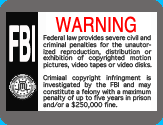|
If you have ever purchased or rented a pre-recorded movie or video property, then you should recognize one of the screenshots below.   This message or something similar to it was shown at the beginning of the recording to inform the viewer, cassette owner, or renter that they do not own the tape's content and that they have no right to make a copy1. This claim was made by the Macrovision Corporation2 for the benefit of the movie industry. It indicates that the recording is covered by a copyright. It also meant that the tape was protected by Copyguard and is going to have a bogus sync pulse placed within the video that will mess with the passive VCR's video electronics. This protection system, introduced in March of 1976 by Sony, was developed for the purpose of preventing the copying of pre-recorded Betamax tapes. It usually didn't affect the unit playing the tape, but it certainly affected a recording being made to a secondary machine. This phony sync pulse confused the automatic gain control (AGC) circuitry of the target VCR. The result was a copy that could have vertical tearing, video noise, or loss of brightness and color. This technique of picture jumbling was called the "Video Blanking" System. There was another one called the "Colorstripe" method that sent a rapidly modulated color burst signal aimed at the VCR's chrominance circuit. This confused the secondary VCR's color processing electronics. In this case the picture was spoiled by horizontal stripes or other unwanted coloration. Both of these systems worked because the doctored signal is being passed along to another device. It normally didn't affect regular playback using a home-use TV. It syncs its picture with the house current, and that cleaned things up. (But sometimes these nasties can be so strong that they will spill over into the original playback video anyway.) This is one reason Sony did not incorporate this protection system into their VCR's, and most Betamax models made prior to 19892 will be unaffected by protection schemes such as these. Why? One reason was their video circuits are designed to correct most of these picture irritations, even when they are on the receiving end (as in when making a copy). Another reason for the omission is because including it in their circuitry would be admitting that Betamax was a party to some kind of unlawful undertaking (that would deprive the studios of content protection). But that special Betamax ability doesn't change the law regarding intellectual property. The Supreme Court has ruled3 that copying material that is protected by copyright is wrong. But ONLY wrong if you intend to distribute it or to profit from the exhibition of it in any way. They ruled that you can copy anything you want for yourself regardless of who owns it and that manufacturers are within their rights to take protective measures to prevent you from doing it. The big thing is having it and watching it is for your own personal enjoyment. Don't loan it to a friend; sell it or broadcast it. You're not even supposed to have friends over for a free movie night. That, too, would be a no-no. So how did this battle over viewing rights get decided anyway? Why do Betamax VCRs prior to 1989 record everything regardless of the source? It happened because early on Sony had to fight for OUR rights to record off-the-air material. They were accused by the entertainment industry of making possible the infringement of THEIR copyrighted properties. Sony didn't want to add credibility to their claim by preventing the use of their Betamax (the guilty party) for recording broadcast TV. That would constitute an admission. Its video circuitry was not designed to prevent recording but rather to faithfully reproduce the NTSC broadcast signal. This made the Betamax suitable for duplicating any video signal that was fed into it, whether it had Copyguard protection or not. They also felt that it was OUR right to make ANY type of recordings (and they wanted to continue selling recorders). Which everybody ended up being allowed to do anyway because the language of the litigation as filed had an exclusion in it that allowed recording of public broadcasts. AND because the public was not going to give up their recorders, not without a much, much bigger fight. So was the battle. During this legal back and forth, good old VHS kept cranking out their VCRs, and they weren't sued. They had decided early on to give in and surrender to Copyguard. They (Mitsushita) didn't want the movie guys on their back. VCRs from both sides kept coming while the Supreme Court was deciding on the case, which eventually ended up nullifying the movie industry's argument. Especially since they began selling their feature films on video while it was being decided. It seems the cash rewards from resurrecting their stale old properties (movies) were just too lucrative for them to pass up. Even if the movie industry had won, the world of recording probably wouldn't have changed much. After all, people had been making copies of copyrighted music for years. The defendents had to have known they were going to lose. Maybe they just wanted to make a point or just slap Sony around. Who knows? But it was messy. 1In September 1989, in the largest U.S. acquisition to date by a Japanese firm, Columbia Pictures Entertainment, Inc. agreed to be acquired by Sony Corp. for $3.4 billion in cash. Sony immediately pledged to put the 65-year-old movie and TV studio in the hands of a Sony U.S. subsidiary and to "keep it as independent as possible, as a full-fledged member of the U.S. film industry." Because Sony became a studio owner, they decided to include Copyguard protection sensitivity in their VCRs made after this date, both Beta and VHS. 2The original Macrovision copy protection system was adopted by VHS and has been expanded to include DVD (digital video disk), VOD (video on demand), PPV (pay-per-view), and other formats. The 1984 film The Cotton Club was the first video to be encoded with Macrovision technology when it was released in 1985. Macrovision as a corporation was established in 1983. 3Sony Corp. of America et al, vs. Universal City Studios, Inc., The Walt Disney Company, et al. Case number 464 U.S. 417 (1984), also known as the famous "Betamax Case", was a decision by the Supreme Court of the United States that ruled that the making of individual copies of complete television shows for purposes of time shifting does not constitute copyright infringement but is fair use. The Court also ruled that the manufacturers of home video recording devices, such as "The Betamax" or other VCR's cannot be liable for infringement. The case was a boon to the home video market, as it created a legal safe haven for the technology. The broader legal consequence of the Court's decision was its establishment of a general test for determining whether a device with copying or recording capabilities ran afoul of copyright law. This test has created some interpretative challenges for courts in applying the case to more recent file-sharing technologies available for use on home computers and over the Internet. |